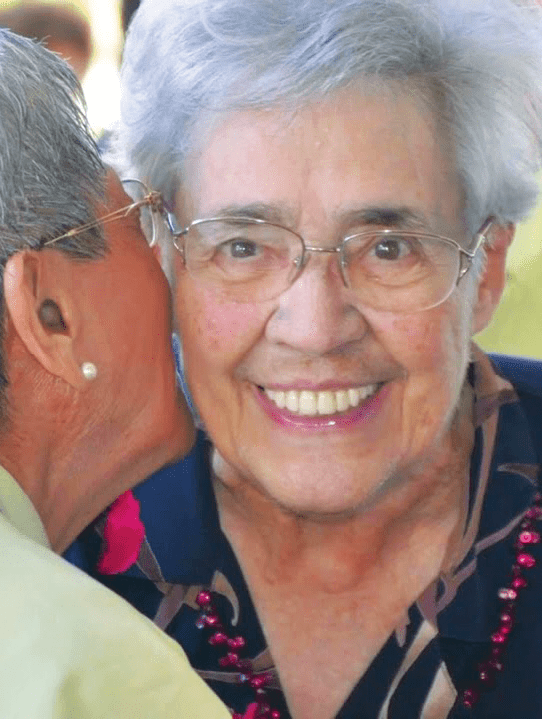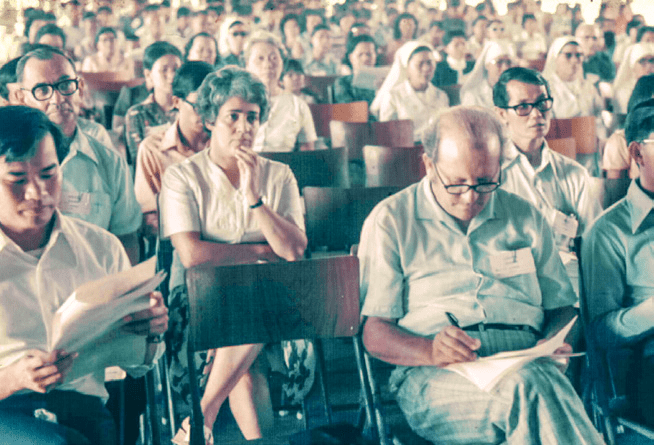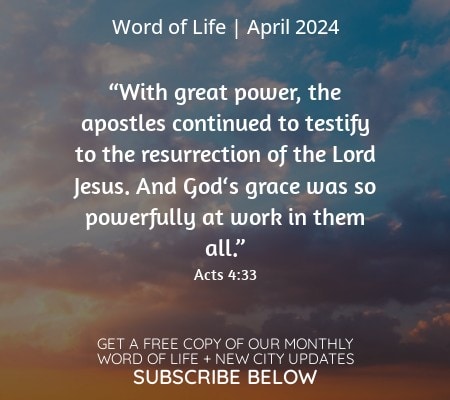
Giò was born in the city of Florence (Italy) on December 20, 1931. She had a beautiful childhood, and described herself as a lively, adventure-loving, and somewhat mischievous kind of girl… With the breaking out of the Second World War, life in the city became difficult. People were going hungry, and the experience of pain made her feel like a prisoner of the world she was born into… It seemed to her that even God was not so present in her life, that He was not interested in her.
Giò wrote: “[On September 25, 1943], bombs fell on Florence for the first time. We didn’t even have time to go down to the cellar, used as an air-raid shelter, when the bombs were already falling, very close to us who were living next to an important railway junction, Campo di Marte. I was quite frightened and prayed one Hail Mary after another… My father… came home running. He told us that, had he found us dead, he would have volunteered to go to the front lines to avenge us. I was struck by the fact that war could make a peaceful man ready to kill. I began to understand a little more.”
Then at war’s end, despite difficult family problems, Giò started to go to the parish again, attracted by some young people of the Catholic Action who were working with great commitment and enthusiasm, also on a political level. In particular, she worked with Vanna del Panta (Gaia), a 17-year-old girl, also from a modest family, who looked after the aspirants and young people of Catholic Action.
On July 23, 1949, through Gaia, Giò was able to attend a meeting of a group of people who were trying to live the Gospel: “I never knew how to express what I understood at that moment. I only know that with a very strong light, I kept on repeating to myself: ‘I have understood God’s logic; now I know how God reasons. Now I know what the world is like. Now I know the meaning of suffering and death… Someone in the meeting had mentioned a sentence of Jesus: “Whatever you do to the least of my brothers, you did it to me”; and it was clear – for the first time! – that this “least” was also my mother. So [I thought:] ‘When I get home, if she would ask me to do something, I have to say yes.’ Until then, I had said very few ‘yeses’… From that day on, every morning was a new discovery: we read the Gospel and, immediately tried to live it, with wonderful results.” That was the beginning of a divine adventure with the small group of the newly formed community of the Movement in Florence.
This is how Giò described her first meeting with the Focolare Movement’s founder, Chiara Lubich:
“At the beginning of November [1949], we heard that Chiara was in transit at the train station in Florence and would be stopping for a few hours to meet our small community. However, Chiara herself did not speak; she let Foco2 read to us an article that she had just written when she returned to Rome from the Dolomite mountains. It was the time when, after the paradise of unity arrived at with her companions, she found herself again in the cold, the solitude, indifference, and boredom of Rome. It was while listening to this writing [The Resurrection of Rome] that I felt the full power of Chiara’s Ideal for the first time, and, in my heart, I found her passion for the unity of all people…”
Fascinated by the light and the revolutionary effect of the Gospel in her life, Giò, at the age of 18, made a choice to give her life totally to God in the same way Chiara had done, a way of consecration in the midst of the world. This is how she narrated that special event: “… What Chiara was saying was so full of light and, at a certain point, that light blinded me… I had to take a step, a new choice, and I didn’t know where to start… I felt that, by now, my life was connected to all the others. I wouldn’t have been able to think of a future without them. I didn’t know what kind of future… but I did know that I wanted to be a focolarina.”
Nevertheless, this fascination was also mingled with moments of uncertainty. But her heart was already conquered by the One she had discovered as the All of her life. She continues: “… I was sure I was a focolarina, and I wouldn’t have wanted to be anything else, but I didn’t have the courage to take the step. Not because of what I had to leave behind, as I had already given practically everything, nor because of what I would lose, so convinced was I that I had found the most beautiful thing. And so? I was afraid because I knew that it would be an “affair” only between me and God, and I felt so small in front of Him who was so great.”
Life went on, and Giò’s life, now totally given to God and for the Ideal she had embraced, turned into a great divine adventure intertwined with moments of great joy, of many discoveries, of evangelical life, and at times, also of melancholy, to which only a sincere yes to Jesus crucified and forsaken gave meaning and light.
To give oneself to God also means being ready to “leave everything” and “go to the whole world…” In the early ‘60s, Giò truly left everything and flew to the USA with two other focolarini to open the first North American focolare center in New York. The life of unity spread in North America among countless people of diverse races, social status, and even those who had different cultural and religious convictions.

In August 1965, Giò was in Ala di Stura, Piedmont (Italy), for a meeting. Seeing her, Chiara said: “Giò, do you know that you are no longer going back to America? You are now going to the Philippines.” And Gio said: “I’m happy, Chiara.” Giò wrote: “Then I went home to look for an atlas to see where the Philippines was, which I confused a bit with the Mariana Islands and the Caroline Islands. As I waited to leave for the Philippines, Chiara thought of sending me meanwhile with other focolarinas to the Canary Islands to collaborate with Fr. Peyton [founder of the Family Rosary Crusade] for the preparation and holding of a big event… I didn’t know God wanted to give me so many graces during those three and a half months. It seemed to me that God wanted to reassure me, to give me courage and tell me that He would support me in the Asian adventure.”
On February 15, 1966 came the departure for the Philippines: “Chiara said to me: ‘Remember, Giò, the Ideal is Jesus Forsaken,’3 and then, with Chiara’s ‘viaticum’ [food for the journey] we left: Giò, with two young Brazilian focolarinas, [and two Italian focolarinos] Silvio Daneo and Cengia [Guido Mirti].”
To make the most out of the multi-city flight ticket, they set off to meet people at each stopover. Giò recounted: “I felt that the 2 billion people in Asia should get to know the Ideal at once. This was a kind of driving force in me. I couldn’t stay a minute without moving.” So, they had a layover in Karachi in Pakistan, Mumbai in India, Yangon in Myanmar, Bangkok in Thailand, and finally, Manila, where, due to a misunderstood telegram message, there was no one to welcome them at the airport…
It is impossible to describe all the experiences, impressions, and anecdotes that followed in meetings, in relationships from which, since the very first days, all the vocations of the Work of Mary were born in an almost exceptional adherence to the charism, thanks also to the work of Father Josef Taschner, SVD who had sown the Ideal of unity in communities all over the Philippines. Giò would say: “Our Lady did everything!”
Here are just a few excerpts from Giò’s letters to Chiara during those early years in Asia:
“Mary had loved me so much in those last days spent in Rome and, to me, it seemed that She was telling me that there was only one thing that I came to do here in Asia: to bring Her (do you remember that my word of life is “Son, here is your mother”?) to bring Her, reliving Her.” (Karachi, February 19, 1965)
“I am in Hong Kong, I arrived here with the desire to work a lot, to do a lot… and as soon as I set foot in Hong Kong, I realized that the only thing I could do was to lose every plan, every aspiration, in Jesus Forsaken.” (Hong Kong, February 11, 1973)
“At this time, I feel in my heart, as I never did before, the passion for “ut omnes” [that all may be one], and I try to communicate it to everyone.” (Tagaytay, May 15, 1980)
Here are some testimonies of people who have been close to Giò:
Gabri, one of Giò’s companions in the focolare center in Parma (Italy): “Dearest Giò! You have reached the goal without our expecting it! But you continue to love us with your simple, great love, ever since you met the Ideal in Florence, among the pioneers there! The trail of light you leave behind: your itinerary from Florence to the USA to Asia… We will miss you!”
Scinti, a focolarino in Mariapolis Peace in Tagaytay (Philippines): “It was a great gift for me to be able to work closely with Giò in the Philippines for ten years. From the moment I arrived, I found in her an elder sister of remarkable intelligence, together with a sense of humor, for she knew how to listen and grasp clearly what was happening in the Movement and in Philippine society in those years. I was always struck by her simplicity and radicality in living the Ideal, her sense of responsibility, and how she made herself one with the various cultures of Asia and Oceania. Above all, I was struck by her lively and constant unity with Chiara, and her love for every development of the Work of Mary in the world, especially in Asia…”
Ester, a volunteer from the USA: “I’m sure all of us have been reflecting, reminiscing, and conversing with Giò (even now that she has “left”), as we’ve done countless times when we were Gen [Focolare youth]. All my thoughts, feelings and memories have been distilled into a sense of unfathomable gratitude for her love, which I’ve experienced in such a personal way. I think that this love must truly reflect Mary’s love, Jesus’ love, God’s love.”
One of Giò’s companions in Rome (Italy) told us: “One day, at sunset, I was beside her and, while looking at the sky, she compared it to her own life, saying that the day was over and that all that remained now was “to make a beautiful sunset.”
Giò remains with us after being blessed with her beautiful sunset, her passing. She leaves a trail of light for us to follow in life, leading us towards the Sun, our destiny, our God of Love.
Romeo Vital and Jose Aranas
1 A consecrated layperson following Chiara Lubich in the vocation to the focolare
2 Igino Giordani, the first married focolarino
3 Refers to Jesus who, on the cross, felt abandoned by His Father, and cried out, “My God, my God, why have You forsaken me?” (Mt 27:46), chosen as the only Ideal of one’s life.




